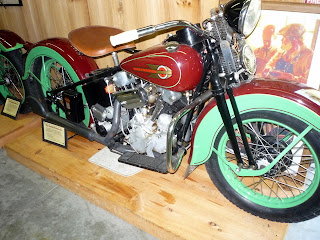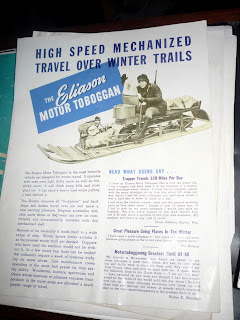October 16, 2010, a little more than a week ago.
I have plans today to nab the current tag in our local tag game. The weather is supposed to be clear but cool, so it should be ideal. I think I know where the tag is located, and I intend to go there before anyone else gets it.
The tag is shown in this photo, and the clue follows:
"Here's a real challenge. Let's see who can find 'no where.' Well, at least that's where the road is supposed to lead. You can just make out the 'secret tunnel' a little way past the barricade. I guess that is a tunnel to nowhere. The pavement ends just the other side of the tunnel.
The 8 miles prior to this picture is a lot of fun.
A picture of your bike at the barricade wins this tag."
I key in on the "road to nowhere" phrase, and find it on the map, near Bryson City North Carolina.
It is a little over a hundred miles one way, so I want to get an early start. I have mapped out the intended route, and find that I have not been on many of the roads. Some of them appear to be quite twisty. We'll see how it goes.
Here is the way I want to go:
View Larger Map
I dress warmly for the ride, as the temperature is about 41 degrees F when I leave. By the way, since it is getting to be cool weather again, it is good to review the gear I wear when it is cold. It is in a posting called Dressing for Cold Weather Riding. Catchy title, eh?
The first part of the route is through familiar territory. I head from Easley to Pickens and up a curvy section of US-178. The Holly Springs Country Store is at the corner where I turn left onto SC-11, the Cherokee Foothills Scenic Highway. This is an easy two-lane road in very good condition through here. Most bikers use it to get from one twisty road to another, or for a leisurely, scenic jaunt to a restaurant.
I turn north again in SC-130. This is the road to Whitewater Falls and Bad Creek, places I have visited many times. Before I reach either, however, I turn onto the Wigington Byway, a very short road with an overlook of Lake Jocassee part way along. This leads to SC-107, the road that will take me most of the rest of the way. The road passes very shortly into North Carolina. It is pretty easy, with a few twists and turns.
I pass by Lake Glenville, and follow the Tuckasegee River until a bit north of Cullowhee, where Western Carolina University has a campus. At the town of Silva, I turn west again on a stretch of US-74. It comes close to the Tuckasegee River again, and in Bryson City, I cross over the river. I am getting close, now.
I cross a railroad and seek out Everett Street, then follow it north. It turns into Lakeview Drive. This is known as the Road to Nowhere. It gets lots of attention simply for its nickname, since it ends just beyond a tunnel inside the bounds of the Great Smoky Mountains National Park.
The road received its name from a dispute during the 1930s and ‘40s when Swain County gave up the majority of its private land to the federal government for the creation of Fontana Lake and the Great Smoky Mountains National Park. Hundreds of people were forced to leave the small communities that had been their homes for generations. The government flooded that land by building Fontana Dam. The hydroelectric power provided by the dam proved vital in helping the government build the atomic bomb in nearby Oak Ridge, Tenn. By the way, Fontana Dam is the highest dam east of the Rocky Mountains, at 480 feet.
The road that led to the area was flooded beneath the waters of the lake, cutting off access to a number of family cemeteries. The federal government made an agreement with Swain County to replace the road with a new one along the lake’s north shore, to be called the North Shore Road -- another catchy name.
Construction of the road began in the 1960s but was halted because of an environmental issue, leaving the road though the tunnel completed, but nothing else. The environmental problems included rotten, unstable rock that would have required much larger cuts through the hills than expected. It was deemed to be too expensive and damaging to the appearance of the parklands, so the road was not completed. The rock is also acidic, and construction may have upset the aquatic life in local streams.
The government runs a ferry service from the south side of Fontana Lake most of the year, so people can visit the isolated cemeteries.
Lakeview Drive is a nice twisty, eight-mile-long section of road. Along the way is an overlook onto an arm of Fontana Lake.
Pretty, isn't it?
The road surface is patched and uneven in places, so I am jolted off my seat a few times, though there isn't much traffic since this is a dead end road. Just outside Great Smoky Mountains National Park, there is a sign that reminds passers by of the broken promise of the 1940s.
[from Western NC Attractions website]
This is my first visit to the National Park on the bike. I won't be seeing any more of it than the tag location, if I find it, since I don't have enough time to stay longer and see more things.
The road ends at a post barrier with the tunnel in sight beyond. The road and tunnel were completed by the end of 1969, but the remaining 26 miles of road have never been finished.
Snap! Now, I have the tag photo, but I want to explore a little.
I note that the place where I park my bike has quite a lot of horse manure around it. I might have known this would be the case, as there are several horse trailers parked here. The equestrians use the park trails extensively.
Fragrant, I'm sure, and this is one of the smaller deposits.
I walk along the road a tenth of a mile or so to the entrance to the tunnel. Here is a closer look at the tunnel entrance. A nearby sign says there are several trails that start beyond the tunnel.
The tunnel construction is similar to those on the Blue Ridge Parkway, having a stone facing and concrete lining.
I venture into the graffiti-covered portal. It seems that most such places are so covered these days, like the one under the Saluda Grade. The pavement inside is rough surfaced, but level. I walk the 1,200-foot length and emerge on a short section of road, complete with wooden timber guardrails. After maybe four hundred feet, the road stops and this trail begins.
Here is a view of the far tunnel portal, taken from the trail. It is a rather picturesque scene, reminiscent of a mid-twentieth-century road.
A view from the entrance. The leaves have started to turn color for Fall, though the peak is a couple of weeks away yet.
The rest of the story about the Road to Nowhere is that the federal government made a cash settlement in February of 2010 in lieu of completing the road. The settlement, paid to Swain County, was for $52,000,000. Completion of the road would have cost at least $600,000,000.
Now, back to the ride.
I take the same route home as I took to get here. My time is limited today, and this tag was further away than most of them that have been posted. I really enjoy the warmth that has replaced the chill of the morning.
Maybe I can return to see some other scenery near here some time.
--------------------------------------------------------------------------------------
[Well, what's this about a "good jumping off place" in the title up there, Bucky?]
Oh. That means that there are a number of other places for motorcyclists and other travelers to visit that are near here.
Great Smoky Mountains Railroad
P.O. Box 1490
226 Everett Street
Bryson City, NC 28713
1-800-872-4681
This is a tourist railroad with fifty-three miles of track, two tunnels and twenty-five bridges, running through fertile valleys and river gorges. The operating locomotives are Diesel-powered.The Great Smoky Mountains Railroad is owned by American Heritage Railways, which is the parent company of the Durango and Silverton Narrow Gauge Railroad and the Texas State Railroad.
The famous train wreck scene in the 1993 Warner Brothers blockbuster movie The Fugitive starring Harrison Ford and Tommy Lee Jones was filmed in Dillsboro North Carolina along the Great Smoky Mountains Railroad. The wreckage set can still be viewed on eastbound Tuckasegee River Excursions departing from Bryson City.
[photo by flickr contributor Jerry James]
The Great Smoky Mountains Railroad was also used in the filming of 1996 Warner Brothers comedy My Fellow Americans starring Jack Lemmon and James Garner when they stumble on to a charter train full of UNC-Chapel Hill fans headed for the NCAA Final Four.Train scenes in the 1998 DreamWorks SKG film Forces of Nature starring Ben Affleck and Sandra Bullock were also filmed here.
Smoky Mountain Trains Museum
P.O. Box 1490
100 Greenlee St.
Bryson City, NC
28713 U.S.A.
1-800-872-4681 x 7050 or 828-488-5200
Great Smoky Mountains National Park
More information.
Wheels Through Time Motorcycle Museum
Twenty-five miles from Bryson City using this route.
62 Vintage Lane
Maggie Valley, NC 28751
1-828-926-6266
For Internet directions, search for: 2914 Soco Road, Maggie Valley, NC 28751
I have posted about my trip to this place.
Tail of the Dragon
Thirty-seven miles from Bryson City to nearest point, using this route.
The famous Dragon begins on the North Carolina side at Fugitive Bridge with a view of the 225 foot high Cheoah Dam where Harrison Ford jumped in the movie The Fugitive. It ends 14 miles across the mountain at the Tabcat Creek Bridge in Tennessee.
There is plenty of information on the website, including riding tips and safety. There are also maps of other good motorcycle roads.
Cherohala Skyway
Thirty-one miles from Bryson City to nearest point, using this route.
This road connects Robbinsville, North Carolina with Tellico Plains, Tennessee. Winding up and over 5,400 foot mountains for fifteen miles in North Carolina and descending another twenty-one miles into the deeply forested backcountry of Tennessee, the road crosses through the Cherokee and Nantahala National Forests. Thus the name "Chero...hala." It has long, sweeping curves, scenic views, and cool summer breezes.
Moonshiner
Two miles from Bryson City to nearest point, using this route.
Stretching from the Tail of the Dragon, Moonshiner 28 winds its way southeastward through Franklin and Highlands North Carolina before turning southward into Georgia and South Carolina at Walhalla.
It was once one of the major runs for moonshiners with revenuers hot on their bumpers. The road today boasts some great twisties, wide sweepers, and unsurpassed scenery. Mountain vistas, waterfalls and secluded lakes appear frequently.
Blue Ridge Parkway
Thirteen miles from Bryson City to nearest point (southern end), using this route.
The Parkway runs for 469 miles (755 km), mostly along the famous Blue Ridge, a major mountain chain that is part of the Appalachian Mountains. Its southern terminus is on the boundary between Great Smoky Mountains National Park and the Cherokee Indian Reservation in North Carolina, from which it travels north to Shenandoah National Park in Virginia and becomes Shenandoah's Skyline Drive.
Reference:
Information about Bryson City. Things to do nearby.
Photos taken in and near Bryson City by Galen R Frysinger.
.
.

.












































































